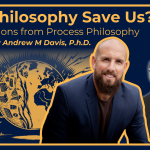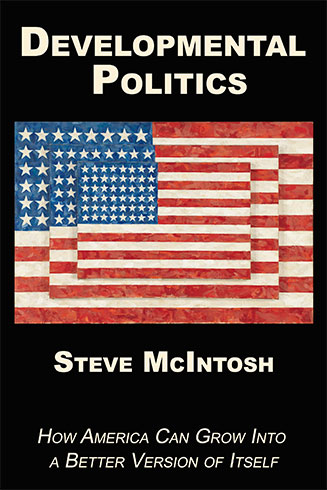Evolution’s Purpose
Chapter Nine: The Promise of a New Evolutionary Worldview
…/snip/…
Elements of an Evolutionary Worldview
It bears repeating here that integral philosophy is essentially a philosophy of evolution; and it is integral philosophy’s enlarged understanding of the evolution of consciousness and culture that reveals where evolution is headed and where our opportunities lie. Examining the historical record using this evolutionary perspective shows how modernism emerged out of traditionalism, and how postmodernism in turn evolved beyond modernism. And this perspective also shows the next stage of cultural evolution that is beginning to appear on the horizon of history.
The rise of the modernist worldview during the Enlightenment was the result of many factors, making a comprehensive analysis of this emergent event beyond the scope of our present discussion. Yet among the many causes of the Enlightenment, historians are in general agreement that the metaphysical philosophy of Rene Descartes was particularly significant. Beginning in the early seventeenth century, Galileo’s demonstration of the heliocentric structure of the solar system had shown the superiority of scientific descriptions of reality over the mythical teachings of the Church. Spurred by these discoveries, Descartes developed an original philosophic foundation for the scientific revolution. His radical philosophy divided reality into a subjective, supernatural world of mind, and an objective, material world of matter. And by doing so he helped inaugurate a new era of reason and scientific discovery. By literally reframing reality using new metaphysical categories, Descartes helped open the eyes of scientists to the “objective” way of seeing and understanding the natural world.
A New Ontology
Now in our time, integral philosophy is doing something very similar; it is reframing reality so as to open up the “ontology of interiors.” Guided by the philosophy of Whitehead, Wilber, and others, as well as by the breakthroughs of system science, integral philosophy has discovered that the worldview structures that provide the steps of evolution for consciousness and culture are actually dynamic systems of agreement that resemble the dynamical systems (also known as “dissipative structures”) found in nature. These worldview systems have both an exterior, physical expression, and also an interior dimension. On the external side, the features of these dynamic systems of culture are fairly straightforward; they can be found in the various forms of communication and social expression through which worldviews are transmitted and consolidated. Yet on the internal side, in addition to the subjective experience of individuals, integral philosophy has revealed a previously unrecognized collective interior aspect of worldview systems. And it is through its expanded recognition of the collective interiors of cultural evolution that integral philosophy reveals a new ontology.
As noted, historically significant worldviews are powerful, multi-generational, large-scale agreements that frame reality and provide identity for those who ascribe to them. And although these agreements are ultimately affirmed and maintained within the subjective consciousness of individuals, there is an element of such agreements that is neither wholly subjective nor completely objective. That is, worldview structures are partially objective, partially subjective, but also partially “intersubjective”—these dynamic systems occupy the “agreement space” that exists in between individuals. Put differently, evolutionarily significant, macro agreements about values occupy multiple domains simultaneously: these worldview systems subsist in objective forms of communication, subjective forms of assent and concurrence, and enduring intersubjective forms of connection that make up a large part of the “interior corpus” of these agreement structures.
This intersubjective aspect of worldview systems is not merely metaphorical. According to integral philosophy, the intersubjective realm is an interior dimension of reality that cannot be reduced to either objective or subjective categories. And it is by recognizing this collective interior dimension of cultural evolution that integral philosophy provides an expanded reality frame; a fresh perspective that helps us better understand the developmental structure of human consciousness and cuture. Of course, cultural worldviews are not conscious entities, but they do exhibit enduring systemic behaviors that resemble other types of self-organizing evolutionary structures such as ecosystems.
Recognizing the similarities between worldview systems and biological systems helps us better understand the “metabolism of values” through which cultural structures maintain their systemic vitality. Just as cells are the micro-systems that make up an organism, agreements about specific values act similarly as the internal micro-systems that aggregate into historically significant worldviews that persist through time. Moreover, as discussed further below, this new understanding of value metabolism can help us better understand why some cultures are vibrant and healthy and why other cultures remain dysfunctional. This expanded ontological recognition of cultural evolution thus allows us to better see, contact, and work with these worldview systems as never before.
Further, integral philosophy’s expanded recognition of interiority avoids the problems of Cartesian dualism by explaining how the subjective category of consciousness (or interiority in general) is not “supernatural”; sentient subjectivity is as real and natural as the external aspects of reality. Building on Whitehead, integral philosophy argues that every naturally occurring form of evolutionary organization possesses an interior aspect. While this recognition of pervasive interiority does not imply that structures such as cells or molecules have consciousness per se, it does show how consciousness does not simply “pop out” at the top of the evolutionary scale. This reframing of reality thus helps avoid the mind/body problem, which has vexed materialistic forms of philosophy for over 300 years.2
So, just as Enlightenment philosophy opened up the externaluniverse to a new era of investigation and discovery through objective science, integral philosophy now promises similar advances within theinternal universe of consciousness and culture. And our growing recognition of the central role of organismal agency and value gravity in the evolution of the universe (discussed in chapter 3) provides an example of the kind of discoveries that can be made through the use of this new form of philosophy. Although a thorough description of integral philosophy’s ontology of interiors is beyond the scope of our discussion, in the sections below we will consider examples of how this new understanding can also be used to diagnose and solve many of the cultural problems that currently plague our world.
A New Epistemology
The “new way of seeing” that arose with the modernist worldview during the Enlightenment came about through the use of the emergent epistemological capacity of reason. Although premodern thinkers also used reason and logic, they lacked a systematic method of analyzing objective reality from a scientific perspective. Nor could they see how the mythical descriptions of the universe provided by their premodern worldviews were in fact inherently unreasonable, if not completely irrational. It was only through the new objective clarity provided by a thoroughly rational worldview that Europeans were able to “disenchant” their understanding of nature. And just as the rise of modernist consciousness provided a new epistemological capacity, the enlarged perspectives of the evolutionary worldview likewise provide the expanded vision of a new epistemological capacity. This new capacity, which Wilber calls “vision-logic,” arises as we come to increasingly view the world through dialectical perspectives.
This dialectical way of knowing can be distinguished from both “formal operational thought” (originally described by Piaget), and “relativistic thought.” Formal operational thinking, which is most often associated with modernist consciousness, usually perceives the world as presenting “right or wrong” choices within a closed system of lawful relationships. Relativistic thinking, which is most often associated with postmodern consciousness, can see the validity of more than one choice, but cannot usually see how such alternatives can be reconciled or synthesized. In contrast to both of these earlier ways of knowing, dialectical thinking always anticipates the possibility of development, and thus perceives the world as a fundamental process of changing dynamic relationships. This dialectical way of seeing thus recognizes how conflicting perspectives can actually work together, mutually supporting each other, even when in apparent opposition, in a manner that can be compared to the function of a tension strut in an architectural structure.
Developmental psychologist Michael Basseches illustrates dialectical thinking using the example of three college students who are each frustrated by standardized assignments and tests, and feel that their freedom and love of learning is being stifled. In this example, the first student (representing formal operational thinking) is angry about his situation, but resigns himself to the unfairness of the system and cynically decides to just give teachers what they want in order to get by. The second student (representing relativistic thinking) is confused; he knows his education would be improved if he had more curricular freedom, but he also “assumes that the college is run by experienced educators, who must have determined that the use of tests and assigned papers to measure and grades to motivate is the soundest educational method.” However, the third student in Basseches’ example (representing dialectical thinking), “reasons that this contradiction will only really be resolved when the basic relationship of the colleges and universities to society is transformed. He decides that he will devote his time at college to trying to learn all he can that might help him contribute to that kind of transformation of educational institutions. He accepts that in the meantime he will be given standardized assignments and grades and will have to make compromises … But he is resolved not to lose sight of his own educational goals.”3 This example thus suggests how dialectical thinkers can take conflicts in their stride, using them for further development. Additional examples are discussed below.
The emergent epistemological capacity of reason that arises with modernist consciousness is a cognitive capacity of the mind, which involves rational thinking. In contrast, the new epistemological capacity that arises with the evolutionary perspective is an emergentvolitional capacity of the will, which comes about mostly through dialectical evaluation. That is, it is usually only by appropriatelyvaluing the elements of a problematic situation that we can correctly perceive the crucial functions of such elements within the situation as a whole. This involves more than simply “weighing the alternatives” and assigning different values to various components; it is a way of understanding and appreciating that requires an intuitive sympathy achieved only by “getting in close”—by identifying with and actually entering into the alternative perspectives that generate opposing values. When we look at evolutionary processes without this ability, all we can see is conflict. But when we come to recognize the unfolding of internal structures through time, we can begin to better appreciate how they are working together within a larger developmental system, and this allows us to engage these structures more effectively. Recognizing this, developmental theorist Robert Kegan actually defines dialectical thinking as “the capacity to see conflict as a signal of our overidentification with a single system.”4
A New Set of Values
As we have seen, historically significant cultural worldviews are made up of discrete sets of values that are related to the problems faced by a given worldview’s “time in history.” Continuing this pattern, the emerging evolutionary worldview also has its own relatively unique values, such as the aspiration to harmonize science and spirituality, an enhanced sense of personal responsibility for the problems of the world, an enlarged appreciation of conflicting truths and dialectic reasoning, and a new appreciation of the significance of evolution in general, and cultural evolution in particular. But unlike older worldviews, this evolutionary perspective also recognizes that every previous worldview contains important values that are necessary for the ongoing functionality of society. As a result of this understanding, the evolutionary view is able to better appreciate and thus better use the healthy values of the entire spectrum of cultural development. And it is by including a wider range of values within its purview that the evolutionary perspective is able to transcend all previous worldviews. Earlier worldviews tend to see each other primarily for their pathologies, discounting the important cultural role that each worldview plays within the larger system of cultural evolution. But the evolutionary perspective can see existing cultural structures within a broader evolutionary context, and can thus more effectively “objectify” earlier values without being repulsed or embarrassed by them.
This process of cultural evolution through objectification is described by Kegan’s well-known “subject-object theory.” Kegan explains the progress of consciousness through the stages of development by observing that a person transcends a given stage when what was previously embedded in that person’s subjective consciousness becomes objectified, or recognized from an external perspective. According to Kegan, “[T]ransforming our epistemologies, liberating ourselves from that in which we were embedded, making what was subject into object so that we can ‘have it’ rather than ‘be had’ by it—this is the most powerful way I know to conceptualize the growth of the mind.”5 For example, in the traditional stage of consciousness, one’s religious belief system is a part of their subject—the traditionalist’s subjective consciousness is embedded or contained within their belief system. The objective world is thus perceived and constructed to satisfy the demands of this belief system. However, when a person transcends the traditional stage and achieves the increased epistemological capacity of modernist consciousness, he may still hold the same essential religious beliefs, but these beliefs are now objectified; he can see beyond his beliefs, and thus gains a greater capacity to adopt the perspective of others and see the world through their beliefs as well as his own. As a person’s consciousness evolves he can still “have his beliefs,” but in more evolved stages those beliefs no longer “have him.”
Kegan’s description of the process of subjective evolution through expanding objectification also helps us understand how the evolutionary worldview makes progress. Unlike previous worldviews, the evolutionary perspective is able to objectify the entire spectrum of established cultural development, and is thus able to achieve an “expanded vertical perspective” that can recognize a new kind of depth. Yet not only does this evolutionary view better objectify previous stages, together with the larger system of which they are a part, it also bettersubjectifies previous stages by identifying with them more closely. As noted, it is only by “getting in close” to the values of these earlier worldviews that we can begin to separate their “dignities” from their “disasters.” Recall that as a result of the dialectic of progress and pathology, successes are often tied to failures in cultural evolution. And this means that the positive values of a given worldview are accordingly tied together with that worldview’s shortcomings. Recovering the useful and enduring values of previous worldviews thus requires careful attention and a sophisticated form of sympathy.
Using the traditional worldview as an example, we can see how the values that we continue to need—values such as honesty, decency, modesty, and personal responsibility—are connected with outlooks that we must now discard—such as sexism, racism, and religious fundamentalism. When we view the traditional worldview from the outside, it is these negative aspects that are often most apparent. But when we come to also see this worldview from the inside, by better identifying with it and partially making it our own, this allows us to better appreciate, and thus tease apart, the core values of this worldview from its remaining outmoded prejudices that continue to hold us back. And as we make common cause with the healthy values of every worldview, “they” become “us.”
A Second Enlightenment
As a result of its place within the sequence of historical development, the emerging evolutionary worldview is in many ways a synthesis of modernism and postmodernism. Without the sensitive and pluralistic values of postmodernism, the evolutionary perspective would be somewhat indistinguishable from cynical modernism. However, although it embraces many postmodern values, this evolutionary worldview also carries forward some of modernism’s important strengths, such as its penchant for problem solving and its focus on progress. Thus, because the evolutionary perspective is a kind of “higher harmonic” of modernism, the historical context out of which this evolutionary view is emerging shows many similarities to the previous appearance of modernism during the Enlightenment. As mentioned, modernism came about through the rise of powerful new philosophical systems, which were rooted in the scientific advances of the seventeenth century. Similarly, this new evolutionary perspective is being catalyzed by philosophical advances in our understanding of emergent evolution, which reveal the influence of values and show how evolution is both driving and drawing the development of human consciousness and culture.
This parallel with the historical events of the Enlightenment can also be seen in the tension between academic philosophy and the new form of philosophy that is giving birth to the evolutionary worldview. In the late seventeenth and early eighteenth centuries, “the officially and legally sanctioned philosophy prevailing in universities and academies, and dominating philosophical and scientific discourse and textbooks” was Scholastic Aristotelianism, a philosophical system that supported the precepts of the Christian Church. Although Scholasticism had been a vibrant part of medieval thought, by the time of the Enlightenment, this academic philosophy had stagnated as a result of having become the handmaiden of religion. Now in our time we can observe a very similar situation wherein the officially sanctioned academic philosophy of our age has become stale. Yet the relative stagnation of contemporary professional philosophy has not resulted from its subservience to the traditional worldview; this time it is subservience to the modernist worldview that has caused the problem. In other words, just as Scholasticism had lost its potency by the time of the first Enlightenment as a result of being compromised by religion, now at the beginning of what may come to be recognized as a kind of “Second Enlightenment,” much of professional philosophy, and especially the philosophy associated with life and evolution, has been similarly compromised by its subordination to science.
Thus, just as in the first Enlightenment, when philosophy was liberated from the static confines of the reigning establishment, leaping forward like a coiled spring, we can now anticipate a similar period of philosophical progress ahead. In the first Enlightenment, philosophy became separated from mythic religion, and now philosophy is becoming similarly liberated from the confines of scientific materialism.
Admittedly, the emergence of the modernist worldview and the rise of science was one of the most significant events in the history of humankind, so these comparisons with the Enlightenment may be overstated. Yet the emergence of this new evolutionary perspective could end up having a similarly dramatic impact on history as a result of its ability to produce social progress. Again, modernist science’s power came from its ability to better understand and thus more effectively control the external, material universe. Similarly, the promise of this emerging evolutionary view is that it can better understand and thus more effectively achieve evolution within the internal universe of consciousness and culture. And a significant part of this enlarged ability to help bring about cultural evolution arises from integral philosophy’s new insights about values.
…/snip/…





